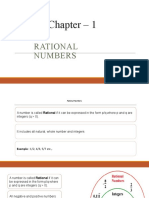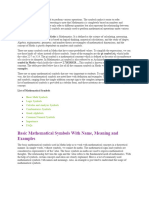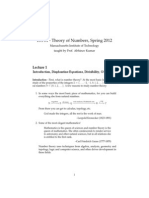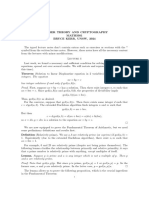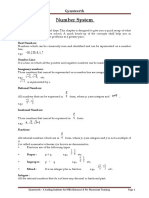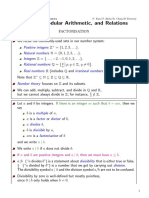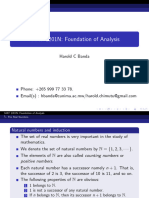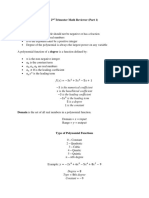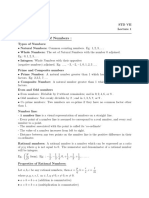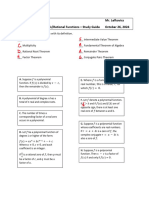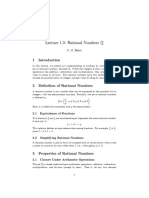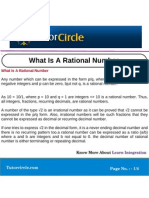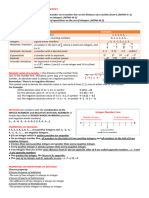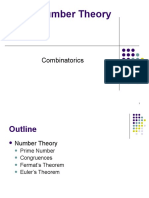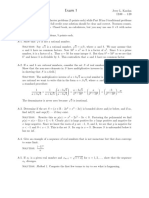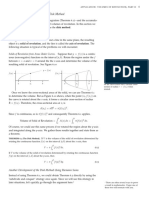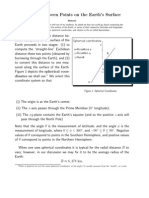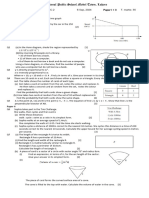Chapter-1 (Rational Numbers) - Introduction Notes
Chapter-1 (Rational Numbers) - Introduction Notes
Uploaded by
aditya.saranguCopyright:
Available Formats
Chapter-1 (Rational Numbers) - Introduction Notes
Chapter-1 (Rational Numbers) - Introduction Notes
Uploaded by
aditya.saranguOriginal Title
Copyright
Available Formats
Share this document
Did you find this document useful?
Is this content inappropriate?
Copyright:
Available Formats
Chapter-1 (Rational Numbers) - Introduction Notes
Chapter-1 (Rational Numbers) - Introduction Notes
Uploaded by
aditya.saranguCopyright:
Available Formats
Chapter-1(Rational Numbers)-Introduction
(A Unit of Delhi Public School PVT.LTD)
Chapter 1: Chapter-1(Rational Numbers)
Chapter Notes
Rational Numbers
A number is called Rational if it can be expressed in the form p/q where p and q are integers (q > 0). It
includes all natural, whole number and integers.
Example: 1/2, 4/3, 5/7,1 etc.
Natural Numbers
All the positive integers from 1, 2, 3,……, ∞.
Whole Numbers
All the natural numbers including zero are called Whole Numbers.
Integers
All negative and positive numbers including zero are called Integers.
Properties of Rational Numbers
1. Closure Property
This shows that the operation of any two same types of numbers is also the same type or not.
a. Whole Numbers
If p and q are two whole numbers then
Operation Addition Subtraction Multiplication Division
Whole p + q will also be the p – q will not always be a pq will also be the whole p ÷ q will not always
number whole number. whole number. number. be a whole number.
Example 6+0=6 8 – 10 = – 2 3 × 5 = 15 3 ÷ 5 = 3/5
Closed or
Closed Not closed Closed Not closed
Not
International DPS,Rajahmundry. Page 1
b. Integers
If p and q are two integers then
Operation Addition Subtraction Multiplication Division
p+q will also be an p-q will also be an pq will also be an p ÷ q will not always be an
Integers
integer. integer. integer. integer.
Example -3+2=–1 5–7=–2 - 5 × 8 = – 40 - 5 ÷ 7 = – 5/7
Closed or
Closed Closed Closed Not closed
not
c. Rational Numbers
If p and q are two rational numbers then
Operation Addition Subtraction Multiplication Division
Rational p + q will also be a p – q will also be a pq will also be a rational p ÷ q will not always
Numbers rational number. rational number. number. be a rational number
p÷0
Example
= not defined
Closed or Not Closed Closed Closed Not closed
2. Commutative Property
This shows that the position of numbers does not matter i.e. if you swap the positions of the numbers then also
the result will be the same.
a. Whole Numbers
If p and q are two whole numbers then
Operation Addition Subtraction Multiplication Division
Whole number p+q=q+p p–q≠q–p p×q=q×p p÷q≠q÷p
Example 3+2=2+3 8 –10 ≠ 10 – 8 – 2 ≠ 2 3×5=5×3 3÷5≠5÷3
Commutative yes No yes No
c. Rational Numbers
If p and q are two rational numbers then
Operation Addition Subtraction Multiplication Division
Rational numbers p+q=q+p p –q ≠ q - p p×q=q×p p÷q≠q÷p
Example
Commutative yes No yes No
International DPS,Rajahmundry. Page 2
3. Associative Property
This shows that the grouping of numbers does not matter i.e. we can use operations on any two numbers first
and the result will be the same.
a. Whole Numbers
If p, q and r are three whole numbers then
Operation Addition Subtraction Multiplication Division
Whole
p + (q + r) = (p + q) + r p – (q – r) = (p – q) – r p × (q × r) = (p × q) × r p ÷ (q ÷ r) ≠ (p ÷ q) ÷ r
number
3 + (2 + 5) = (3 + 2) + 8 – (10 – 2) ≠ (8 -10) – 3 × (5 × 2) = (3 × 5) × 10 ÷ (5 ÷ 1) ≠ (10 ÷ 5) ÷
Example
5 2 2 1
Associative yes No yes No
b. Integers
If p, q and r are three integers then
Operation Integers Example Associative
Addition p + (q + r) = (p + q) + r (– 6) + [(– 4)+(–5)] = [(– 6) +(– 4)] + (–5) Yes
Subtraction p – (q – r) = (p – q) – r 5 – (7 – 3) ≠ (5 – 7) – 3 No
Multiplication p × (q × r) = (p × q) × r (– 4) × [(– 8) ×(–5)] = [(– 4) × (– 8)] × (–5) Yes
Division p ÷ (q ÷ r) ≠ (p ÷ q) ÷ r [(–10) ÷ 2] ÷ (–5) ≠ (–10) ÷ [2 ÷ (– 5)] No
c. Rational Numbers
If p, q and r are three rational numbers then
Operation Integers Example Associative
Addition p + (q + r) = (p + q) + r yes
International DPS,Rajahmundry. Page 3
Subtraction p – (q – r) = (p – q) – r No
Multiplicationp × (q × r) = (p × q) × r yes
Division p ÷ (q ÷ r) ≠ (p ÷ q) ÷ r No
The Role of Zero in Numbers (Additive Identity)
Zero is the additive identity for whole numbers, integers and rational numbers.
Identity Example
Whole number a+0=0+a=a Addition of zero to whole number 2+0=0+2=2
Integer b+0=0+b=b Addition of zero to an integer False
Rational number c+0=0+c=c Addition of zero to a rational number 2/5 + 0 = 0 + 2/5 = 2/5
International DPS,Rajahmundry. Page 4
The Role of one in Numbers (Multiplicative Identity)
One is the multiplicative identity for whole numbers, integers and rational numbers.
Identity Example
Whole number a ×1 = a Multiplication of one to the whole number 5×1=5
Integer b × 1= b Multiplication of one to an integer -5×1=–5
Rational Number c × 1= c Multiplication of one to a rational number
Negative of a Number (Additive Inverse)
Identity Example
Whole number a +(- a) = 0 Where a is a whole number 5 + (-5) = 0
Integer b +(- b) = 0 Where b is an integer True
Rational number c + (-c) = 0 Where c is a rational number
Reciprocal (Multiplicative Inverse)
The multiplicative inverse of any rational number
Example
The reciprocal of 4/5 is 5/4.
Distributivity of Multiplication over Addition and Subtraction for Rational Numbers
This shows that for all rational numbers p, q and r
1. p(q + r) = pq + pr
2. p(q – r) = pq – pr
Example
Check the distributive property of the three rational numbers 4/7,-( 2)/3 and 1/2.
Solution
Let’s find the value of
International DPS,Rajahmundry. Page 5
This shows that
International DPS,Rajahmundry. Page 6
Representation of Rational Numbers on the Number Line
On the number line, we can represent the Natural numbers, whole numbers and integers as follows
Rational Numbers can be represented as follows
Rational Numbers between Two Rational Numbers
There could be n number of rational numbers between two rational numbers. There are two methods to find
rational numbers between two rational numbers.
Method 1
We have to find the equivalent fraction of the given rational numbers and write the rational numbers which
come in between these numbers. These numbers are the required rational numbers.
Example
Find the rational number between 1/10 and 2/10.
Solution
As we can see that there are no visible rational numbers between these two numbers. So we need to write the
equivalent fraction.
2/10 = 20/100((multiply the numerator and denominator by 10)
Hence, 2/100, 3/100, 4/100……19/100 are all the rational numbers between 1/10 and 2/10.
Method 2
We have to find the mean (average) of the two given rational numbers and the mean is the required rational
number.
Example
Find the rational number between 1/10 and 2/10.
Solution
To find mean we have to divide the sum of two rational numbers by 2.
International DPS,Rajahmundry. Page 7
3/20 is the required rational numbers and we can find more by continuing the same process with the old and
the new rational number.
Remark: 1. This shows that if p and q are two rational numbers then (p + q)/2 is a rational number between p
and q so that
p < (p + q)/2 < q.
2. There are infinite rational numbers between any two rational numbers.
International DPS,Rajahmundry. Page 8
You might also like
- Ls Maths9 2ed TR Workbook AnswersDocument49 pagesLs Maths9 2ed TR Workbook AnswersVANSHIKA AGARWAL88% (64)
- ACT数学难题集(蒋正浩老师)Document205 pagesACT数学难题集(蒋正浩老师)o100% (1)
- Real NumbersDocument15 pagesReal NumbersAbby LumanglasNo ratings yet
- Infinity, Series - Taylor - and Analytical Functions.Document9 pagesInfinity, Series - Taylor - and Analytical Functions.George Mpantes mathematics teacherNo ratings yet
- Math Bridge Course 7th - 8thDocument42 pagesMath Bridge Course 7th - 8thrrishithak29No ratings yet
- Chapter - 1: Rational NumbersDocument21 pagesChapter - 1: Rational NumbersRiddhi100% (1)
- Mathematics Symbol SDocument14 pagesMathematics Symbol Sgabbarmachi101No ratings yet
- Basic Mathematical SymbolsDocument12 pagesBasic Mathematical SymbolsAllyson Angel IturiagaNo ratings yet
- Class 7 - Ch.1 Integers NotesDocument11 pagesClass 7 - Ch.1 Integers Notesjanvi mehtaNo ratings yet
- Basic Mathematical Symbols With Name, Meaning and ExamplesDocument12 pagesBasic Mathematical Symbols With Name, Meaning and Examplesaltheafaustino1004No ratings yet
- Theory of NumbersDocument117 pagesTheory of NumbersCARTER86No ratings yet
- Sanet - ST B07QN7J2T7Document51 pagesSanet - ST B07QN7J2T7Nour El Dien MNo ratings yet
- Week 2Document9 pagesWeek 2Ethan MayNo ratings yet
- Topic 1 2324 Am015 StudentDocument48 pagesTopic 1 2324 Am015 StudentAARON HANTON A/L ANTHONY EDWARD MoeNo ratings yet
- NumberTheory Complete PDFDocument23 pagesNumberTheory Complete PDFArka SenguptaNo ratings yet
- NumberTheory Complete PDFDocument23 pagesNumberTheory Complete PDFMaria Cleofa CatuizaNo ratings yet
- 6H Kelompok 1 PPT Number and OperationsDocument24 pages6H Kelompok 1 PPT Number and OperationsMuhammad Ribhi MurobbiNo ratings yet
- b1p1c1 FunctionlimitcontinuityDocument46 pagesb1p1c1 FunctionlimitcontinuityGodsent SongNo ratings yet
- Oswaal CBSE Class 9 Mathematics Revision Notes For 2023 ExamDocument39 pagesOswaal CBSE Class 9 Mathematics Revision Notes For 2023 ExamSamridhi SharmaNo ratings yet
- Campus AptitudeDocument98 pagesCampus AptitudePallavi BhartiNo ratings yet
- Udgam School For Children: Std. VII - Maths (2022-23)Document11 pagesUdgam School For Children: Std. VII - Maths (2022-23)mitesh shahNo ratings yet
- Topic 2 Lecture NotesDocument36 pagesTopic 2 Lecture NoteskellyNo ratings yet
- Maths JeeDocument32 pagesMaths Jeetapanmukhopadhyay066No ratings yet
- Crypto Maths - Part 1Document21 pagesCrypto Maths - Part 1abhishek reddyNo ratings yet
- 7th Mathematics DLP Study Package FinalDocument173 pages7th Mathematics DLP Study Package FinalAdityaNo ratings yet
- RatnoDocument26 pagesRatnoKartik chaudharyNo ratings yet
- Lecture 1_Real NumbersDocument25 pagesLecture 1_Real NumberskennedytisungeniNo ratings yet
- Kanakkupillai SundharjiDocument1,060 pagesKanakkupillai Sundharjisundar jiNo ratings yet
- SMA 2104 Maths For SciencesDocument75 pagesSMA 2104 Maths For Sciencesmmatur057No ratings yet
- Grade 10 Activity Sheets Quarter 3 Week 1Document14 pagesGrade 10 Activity Sheets Quarter 3 Week 1cedrick playz100% (1)
- 2nd Trimester Math ReviewerDocument26 pages2nd Trimester Math ReviewerJan Michael RojasNo ratings yet
- Basic Properties of NumbersDocument5 pagesBasic Properties of NumberspreetiNo ratings yet
- Number SystemsDocument14 pagesNumber Systemsapi-185034533No ratings yet
- CO3 Session 21Document8 pagesCO3 Session 21vivekdhanisetti2005No ratings yet
- Module 1 Unit 1A PreCalc ConceptsDocument9 pagesModule 1 Unit 1A PreCalc Conceptskorleon gNo ratings yet
- #Topic 5 Relations, Mapping and FunctionsDocument13 pages#Topic 5 Relations, Mapping and FunctionsjamesbriandunguNo ratings yet
- Precalculus_Chapter4_Polynomials_RationalFunctions_StudyGuide_Oct28_2024_KEYDocument6 pagesPrecalculus_Chapter4_Polynomials_RationalFunctions_StudyGuide_Oct28_2024_KEY2027.swetha.karthikeyanNo ratings yet
- Lecture 1.3 The Set of Rational Numbers QDocument3 pagesLecture 1.3 The Set of Rational Numbers QBahriNo ratings yet
- SMA 2104 Maths For SciencesDocument44 pagesSMA 2104 Maths For SciencesjassirNo ratings yet
- SMA 2170 AlgebraDocument64 pagesSMA 2170 Algebrastephen.wambui2022No ratings yet
- Rational Numbers Rational Numbers Rational Numbers Rational Numbers Rational NumbersDocument32 pagesRational Numbers Rational Numbers Rational Numbers Rational Numbers Rational NumbersAjiteshPadda100% (1)
- What Is A Rational NumberDocument4 pagesWhat Is A Rational NumbernishagoyalNo ratings yet
- 6H - Kelompok 1 - PDF - Number and OperationsDocument24 pages6H - Kelompok 1 - PDF - Number and OperationsMuhammad Ribhi MurobbiNo ratings yet
- Computing Roots Modulo PDocument3 pagesComputing Roots Modulo PoliverjohnboydNo ratings yet
- Math Formula SheetDocument17 pagesMath Formula SheetAnkit RajNo ratings yet
- Integers Learning MaterialsDocument3 pagesIntegers Learning MaterialsRHEA FAITH VILLASISNo ratings yet
- Number Theory: CombinatoricsDocument27 pagesNumber Theory: CombinatoricslonelygirlNo ratings yet
- 202 F13 Ex 1 SolnsDocument4 pages202 F13 Ex 1 Solnsgustjr0526No ratings yet
- CMO Olympiad Book For Class 9Document13 pagesCMO Olympiad Book For Class 9Anjali Kumari100% (1)
- Std-8 Sem-1 Math Chp-1Document11 pagesStd-8 Sem-1 Math Chp-1lavkumarmishra963No ratings yet
- SMA 2104 Maths for SciencesDocument69 pagesSMA 2104 Maths for Sciencesycj58bvs2x100% (1)
- Chapter 1 Rational NumbersDocument20 pagesChapter 1 Rational NumbersMohammed Nadeemullah NNo ratings yet
- 1 Real NumbersDocument61 pages1 Real NumbersMonic RomeroNo ratings yet
- Math 7 Week 4 Q1Document14 pagesMath 7 Week 4 Q1Carl Joshua FranciscoNo ratings yet
- Class 8 Maths NotesDocument37 pagesClass 8 Maths Notesbadge21.2010No ratings yet
- Real Numbers: Fundamental Theorem of ArithmeticDocument24 pagesReal Numbers: Fundamental Theorem of ArithmeticPrashanth YadhavNo ratings yet
- Leonardo FibonacciDocument10 pagesLeonardo FibonacciJahara Mae CalmaNo ratings yet
- 10+2 Level Mathematics For All Exams GMAT, GRE, CAT, SAT, ACT, IIT JEE, WBJEE, ISI, CMI, RMO, INMO, KVPY Etc.From Everand10+2 Level Mathematics For All Exams GMAT, GRE, CAT, SAT, ACT, IIT JEE, WBJEE, ISI, CMI, RMO, INMO, KVPY Etc.No ratings yet
- Let's Practise: Maths Workbook Coursebook 7From EverandLet's Practise: Maths Workbook Coursebook 7No ratings yet
- DLP Grade 6 MathDocument9 pagesDLP Grade 6 MathLelyn BalingitNo ratings yet
- UntitledDocument7 pagesUntitledRajarshiNo ratings yet
- Self Narrative ReportDocument2 pagesSelf Narrative ReportJohn Gladhimer CanlasNo ratings yet
- Resume 1Document3 pagesResume 1api-216340766No ratings yet
- HW 7 SolsDocument17 pagesHW 7 SolsAmal MendisNo ratings yet
- Chapter 23Document48 pagesChapter 23narasimha100% (1)
- Dekalb County Schools Homework PolicyDocument8 pagesDekalb County Schools Homework Policyg3q09nh8100% (1)
- Disk MethodDocument11 pagesDisk MethodFasih Ul HaqNo ratings yet
- 2032611082maths Psa Quantitative Aptitude For Class VII 2014-15 PDFDocument67 pages2032611082maths Psa Quantitative Aptitude For Class VII 2014-15 PDFAnonymous cTtLqZAgNo ratings yet
- Program Coronation 2024Document2 pagesProgram Coronation 2024CHARD DEE VLOGSNo ratings yet
- Class 9 Chapter 6 Worksheet Math Lines and Angles: InstructionsDocument12 pagesClass 9 Chapter 6 Worksheet Math Lines and Angles: InstructionsyounisNo ratings yet
- QA-05 Ratio-2 - QDocument31 pagesQA-05 Ratio-2 - Qlalit kumawatNo ratings yet
- Area Under The Curve - JEE (Main) - 2024Document82 pagesArea Under The Curve - JEE (Main) - 2024Abhijit Prasad100% (1)
- Math 7 Q2 ExamDocument3 pagesMath 7 Q2 ExamJeric Garcia-Raut PinasNo ratings yet
- First Grade SLO Math Assessments, Pre and Post2Document37 pagesFirst Grade SLO Math Assessments, Pre and Post2Sai Sunil ChandraaNo ratings yet
- IsometricDocument2 pagesIsometricanandandmeenaNo ratings yet
- HaversineDocument4 pagesHaversineImtiazAliShaukatNo ratings yet
- CTS Quants 13-18 - 6822Document6 pagesCTS Quants 13-18 - 6822Siva Teja RajaneniNo ratings yet
- CV Andres Alejandro Lopez GaleasDocument1 pageCV Andres Alejandro Lopez GaleasStephany ZamoraNo ratings yet
- Miss Taylor Cyr: Professional ProfileDocument2 pagesMiss Taylor Cyr: Professional Profileapi-406678232No ratings yet
- JEE+Crash+course+ +Phase+I+ +session+1+ +Sets+and++Relations+&+Functions+ +7th+nov+Document140 pagesJEE+Crash+course+ +Phase+I+ +session+1+ +Sets+and++Relations+&+Functions+ +7th+nov+ananshi 10c2020100% (1)
- Answers 1.2Document5 pagesAnswers 1.2visiting mathematicsNo ratings yet
- Continuity & Differentiability (Practice Question)Document14 pagesContinuity & Differentiability (Practice Question)parassethNo ratings yet
- Weekend Task 11 C-2 2024Document1 pageWeekend Task 11 C-2 2024rohaim571No ratings yet
- Area of Rectangle, Trapezium and KiteDocument3 pagesArea of Rectangle, Trapezium and Kitemohammed mahdyNo ratings yet
- Triangle Angel Sum Worksheet 4Document2 pagesTriangle Angel Sum Worksheet 4sharrawyNo ratings yet
- Third Space Learning Angles in Quadrilaterals GCSE WorksheetDocument19 pagesThird Space Learning Angles in Quadrilaterals GCSE WorksheetAngelina IngkiriwangNo ratings yet
- Deloitte PapersDocument9 pagesDeloitte PapersAnuj Kumar0% (1)





